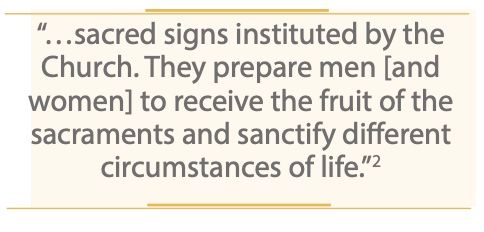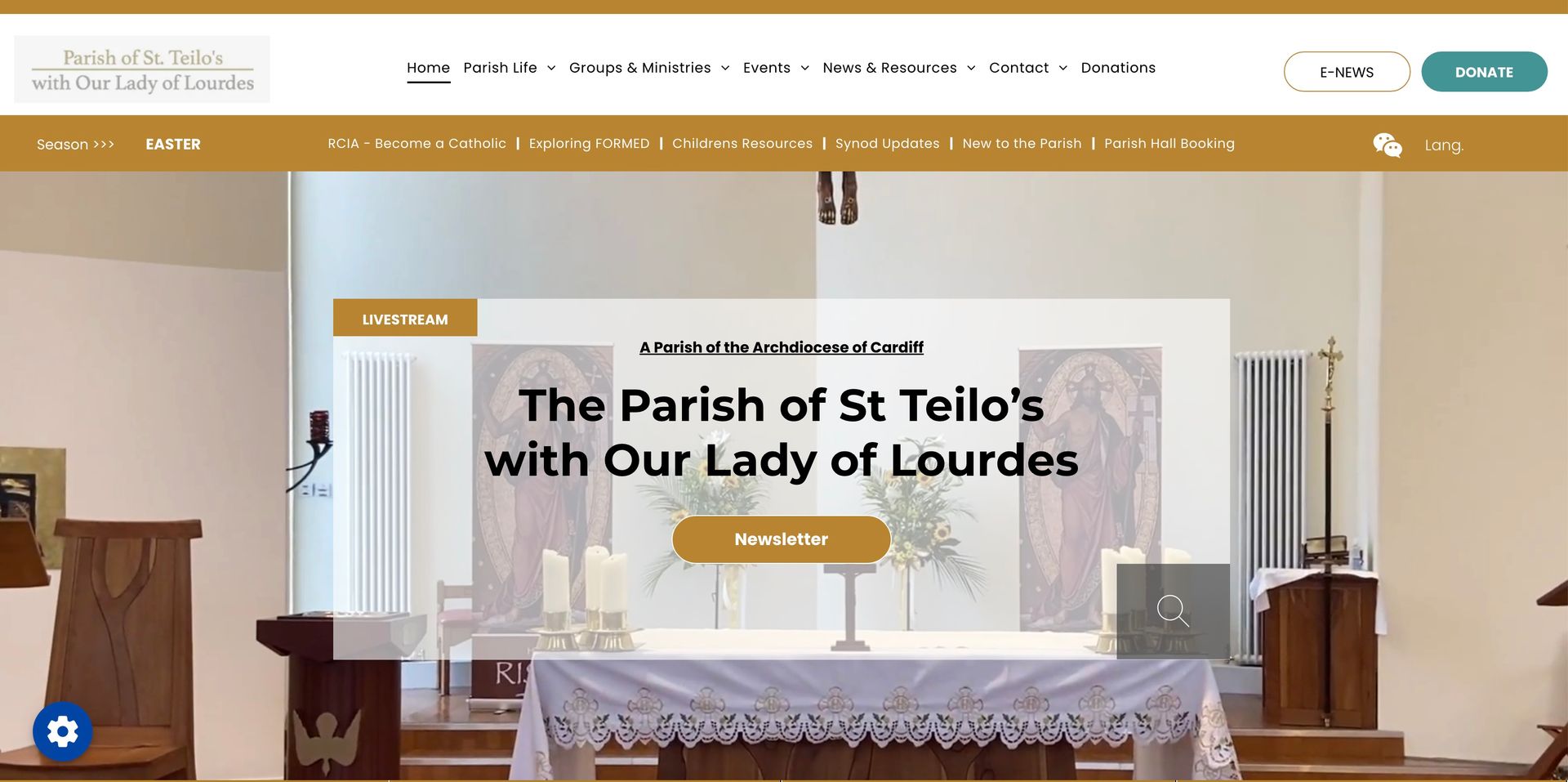Sacramentals

Sacraments and sacramentals are closely linked, as their names suggest. In describing sacraments, to summarise the ‘Catechism of the Catholic Church’, (1994:1084), Christ pours out the Holy Spirit upon His Body, the Church, and acts through the Sacraments which He instituted to communicate His Grace.1 So, sacraments are signs, be they words or actions, through which the action of Christ and the power of the Holy Spirit effectively make present His Grace bestowed upon us all.
My understanding of our Faith is the Creator of the world, the Lord Our God, created the world out of an abundance of Love that flflows outward from the Heart of the Trinity. This supernatural Love is dynamic and cannot be contained. When the Good Lord created humanity in Adam and Eve, His creative Love and favour didn’t end there, but continues to bestow upon humankind this Loving Grace, especially through the action of His Son who became flflesh, was crucifified, died and rose again to redeem us, sending the Holy Spirit who continues to communicate that Grace to us today. I believe Our Father didn’t just create humankind once and for all, He continues to create and sustain us every minute of every day and invites us, through His Grace poured out upon and through the Church, to co-operate with Him to make Christ alive and present in the world today. Sacramentals are one way of reminding us of this Grace bestowed upon us which we receive in a fuller way through the Sacraments. So let us take a closer look at what sacramentals are.

So, by using sacramentals, the grace we receive from the Church can, in part, be carried with us as we leave to go about our daily lives. Sacramentals can increase our devotion, helping us to draw closer to Christ, God with us. Sacramentals can be material objects like medals, Crosses and Crucifixes, scapulars, holy oils, candles, palms and ashes, holy water, sacred images and statues, Rosaries and chaplets, prayer books and Bibles, and also actions like blessings, exorcisms, and liturgical gestures.3 However, what we are considering in this article are sacramentals which are physical items only.4

The ‘Catechism’ (nn.1667-1670) lays out the theology of sacra- mentals as such:
“Holy Mother Church has, moreover, instituted sacramentals. These are sacred signs which bear a resemblance to the sacraments. They signify effects, particularly of a spiritual nature, which are obtained through the intercession of the Church. By them men [and women] are disposed to receive the chief effect of the sacraments, and various occasions in life are rendered holy.
“...Sacramentals are instituted for the sanctification of certain ministries of the Church, certain states of life, a great variety of circumstances in Christian life, and the use of many things helpful to man [and woman]. In accordance with bishops’ pastoral decisions, they can also respond to the needs, culture and special history of the Christian people of a particular region or time. They always include prayer, often accompanied by a specific sign, such as the laying on of hands, the sign of the Cross, or the sprinkling of holy water (which recalls Baptism).
“Sacramentals derive from the baptismal priesthood: every baptized person is called to be a ‘blessing’ and to bless. Hence, lay people may preside at certain blessings; the more a blessing concerns ecclesial and sacramental life, the more is its administration reserved to the ordained ministry (bishops, priests, or deacons).
“Sacramentals do not confer the grace of the Holy Spirit in the way that the sacraments do, but by the Church’s prayer, they prepare us
to receive grace and dispose us to cooperate with it. ‘For well-disposed members of the faithful, the liturgy of the sacraments and sacramentals sanctifies almost every event of their lives with the divine grace which flows from the Paschal mystery of the Passion, Death and Resurrection of Christ. From this source all sacraments and sacramentals draw their power. There is scarcely any proper use of material things which cannot be thus directed toward the sanctification of men [and women] and the praise of God.’”
Sacramentals are a particular feature of the Catholic Faith and can be a major stumbling block for non-Catholics. Sacraments are dependent on God’s power, in which grace derived from Christ’s Passion, is communicated to the recipient through the Church’s minister of the Sacrament, and through the sacrament itself, which causes the grace that it signifies, as long as the recipient does not block the effect of grace by placing “an obstacle in the way.”1 The sanctifying grace conferred through the Sacraments comes from an inherent power within the rite of the Sacrament itself as an act of Christ, whereas grace given through sacramentals is dependent on the disposition of the recipient. The Church emphasizes the importance of the blessing of items that endows a spiritual character, transforming them into sacramentals. As the ‘Catechism’ says:


However, there is a hierarchy within the Church in that a blessing from a bishop or priest has the power to transform an item into a sacramental, whereas a blessing from a Lay person is more like a prayer or a plea to God. It is only through the blessing bestowed by clergy that an item can become a sacramental. Although the sacramentals we use today are not in Scripture as such, there are many passages that support their use, such as: 2 Kings 5:10 showing the use of water for ritual healing and purification and Luke 8:43-44 where the woman with the hemorrhage touches the hem of Christ’s garment and is healed immediately. There are many more Scripture passages in support of sacramentals.
Some non-Catholics may see the use of sacramentals as just superstition, so what is the difference between the correct use of sacramentals and superstition? Regina Doman answers this question by saying that it has to do with inner attitude. Superstition is not something of the Faith as it is akin to magic. Doman says the superstitious person says, “If I sprinkle holy water, say these prayers and cross myself,
I can make God, or His Saints, do such and such for me.” However, the person using a sacramental in the correct manner says, “I want to draw closer to God – to be constantly reminded of the power of His Love and the glory of His protection, forgiveness and mercy.” So sacramentals are used to make our Faith stronger and help us draw closer to God in Faith. Sacramentals are a way of weaving our Faith into the ordinariness of our lives, allowing us to be reminded of God’s Grace and Blessings upon our lives beyond the Church. Doman gives some good examples: a father who sprinkles holy water around the beds of his young children before they go to bed, whilst praying for God’s protection against nightmares which had been a problem; and a mother who uses blessed salt to bake bread for her family. I have also seen car engines being blessed with holy oil before a long journey. I touch my Crucifix when eeling anxious as a reminder that God is with me, with a silent prayer asking for His Blessing and protection.
To summarise then, the Sacraments of the Church are of Divine institution where Christ Himself makes efficacious the grace received, whereas sacramentals are instituted by the Church and their efficacy, in part, depends on the devotion, Faith, and charity of the person who uses them. Using artistic license here, I am reminded of St Ignatius of Loyola who asked his retreatants and students to close their eyes and imagine God’s Grace pouring out upon them in what he described as warm rays of sunshine touching the skin or a shower of rain falling upon them.
From the moment of our creation God has showered His Love and Grace upon us continually, however, when Christ established the Church and instituted the Sacraments God’s Grace comes to us in a new way in the New Covenant. Through Christ, Grace is bestowed upon us through the Church’s minister of the Sacrament and when this same minister blesses an object like a candle, a spiritual character is conferred to make the candle holy and marked out for a sacred purpose, like lighting the blessed candle during prayer. I like to think that if I take home a blessed candle, statue or Rosary, I carry home a sign of God’s Grace to increase my Faith, love and devotion. Like one of St Ignatius’ rays of sunshine, when I’m at home it becomes a constant reminder of God’s Love for me and His closeness, thus sanctifying my home and my life.
REFERENCES
1 Catechism of the Catholic Church. 1994. Note 1084. Found at: https://www.catholicculture. org/search/searchResults.cfm?querynum=1&se archid=2178734&showCount=1&fulltext=no& returnpage=https%3A%2F%2Fwww%2Ecatho licculture%2Eorg%2Fculture%2Flibrary%2Fcat echism%2Findex%2Ecfm&CFID=46786118&CF TOKEN=607d4bb403e70377-1038DF90-AE09- 2FC9-F414B3C080332B1C Accessed on 27th January 2022.
2 Catechism of the Catholic Church.
1994. Note 1677. Found at: https://www. catholicculture.org/search/searchResults.cfm? querynum=1&searchid=2178734&showCount =1&fulltext=no&returnpage=https%3A%2F%2 Fwww%2Ecatholicculture%2Eorg%2Fculture% 2Flibrary%2Fcatechism%2Findex%2Ecfm&CFI D=46786118&CFTOKEN=607d4bb403e70377- 1038DF90-AE09-2FC9-F414B3C080332B1C Accessed on 27th January 2022.
3 World of Sacramentals. 2019. “List of
Catholic Sacramentals”. Found at: https:// worldofsacramentals.com/list-of-sacramentals/ Accessed on 24th January 2022.
4 Behind the Catholic Counter. 2016. “What
is a Sacramental?” Found at: https://blog. aquinasandmore.com/what-are-sacramentals/ Accessed on 24th January 2022.
5 Catholicism.org “Sacramentals and Relics Found at https://catholicism.org/sacramentals- and-relics Accessed on 15/2/2022
6 Catechism of the Catholic Church.
1994. Note 1671. Found at: https://www. catholicculture.org/search/searchResults.cfm? querynum=1&searchid=2178734&showCount =1&fulltext=no&returnpage=https%3A%2F%2 Fwww%2Ecatholicculture%2Eorg%2Fculture% 2Flibrary%2Fcatechism%2Findex%2Ecfm&CFI D=46786118&CFTOKEN=607d4bb403e70377- 1038DF90-AE09-2FC9-F414B3C080332B1C Accessed on 27th January 2022.
7 O’Neill, E. 2021. “What Are Sacramentals?” Found at: https://www.simplycatholic.com/ what-are-sacramentals/ Accessed on 27th January 2022.
8 Doman, R. 1996. “Sacramentals: What Are They?” Found at: https://www.ewtn.com/ catholicism/library/sacramentals-what-are- they-1171 Accessed on 27th January 2022.










